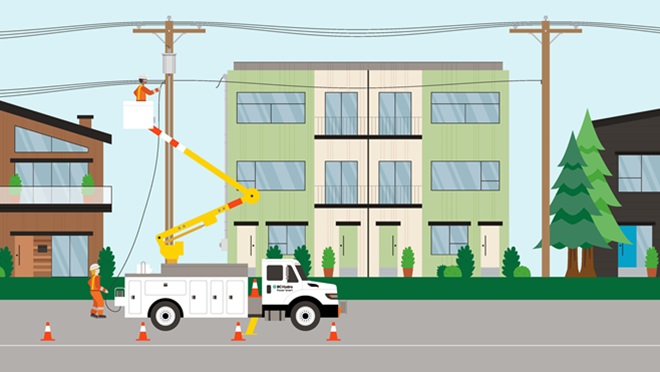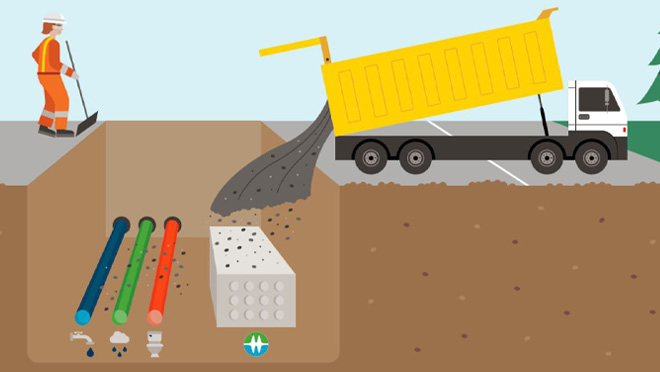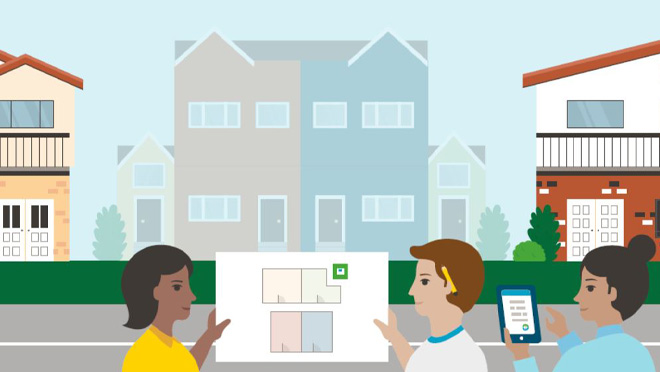BC Hydro and local government collaborations
Find out how we've partnered with local governments to discover innovate ways to reduce costs, improve efficiency, and minimize community disruptions.
Explore our case studies below.
On this page:
- Case study: Connecting early for electrical infrastructure in Saanich and Victoria
- Case study: Balancing urban trees and power lines
- Case study: Using mapping tools to support shared capital planning
- Case study: Digging up the road once, in Surrey and beyond
- Case study: Lessons from missing-middle housing in Vancouver
If you'd like to know more, or have ideas for collaboration, reach out via localgov@bchydro.com.

Many new housing developments in B.C. progress well into the municipal approval process before BC Hydro’s brought into the conversation. This has often led to delays, costly redesigns, the loss of trees that could’ve been saved, and frustrated developers.
To address this, the District of Saanich and the City of Victoria partnered with BC Hydro to launch two new approaches aimed at earlier collaboration in development planning. Their shared goal: improve consultation and share project information earlier in the development timeline to reduce friction and surprises later.
“Developers have been asking for clearer processes, and more predictable outcomes. They want that predictability and early sign-off from BC Hydro that mitigates future problems during construction.”
– Alex Kearney, BC Hydro’s senior design manager for Vancouver Island
Saanich: A pre-application pilot for early input
The District of Saanich launched a new pre-application pilot and engaged BC Hydro to offer guidance on electrical servicing requirements as part of an expedited, high-level, cross-departmental review of proposed 4-to-8-storey multi-family and townhouse developments.
“We are early in trying this process out, but we see value in getting BC Hydro’s early input. It creates better understanding between the developer, BC Hydro, and the municipality. We’re giving it a go, and we’re excited about this.”
– Jon Poole, District of Saanich development planning process manager
Victoria: Civil sign-off for better coordination
BC Hydro worked with the City of Victoria (the City) to create a civil sign-off process in response to a city bylaw. The bylaw mandates that developers engage with BC Hydro to ensure that electrical requirements are met before the city issues a building permit. The civil sign-off process aims to align understanding between the City and BC Hydro. It includes questions about the level of electrical service required, the design of the civil infrastructure, and potential impacts on trees.
“The civil sign-off document helped our teams understand where development projects are at and strengthen communication and collaboration with BC Hydro. It’s helped us avoid stressful situations when conflicts with electrical infrastructure are encountered at a late stage.”
– Brent Molnar, the City of Victoria’s manager of land development
This early alignment with the City will save roughly 20 days per project and 450 employee hours per year. The document also helps the City better understand a project’s status and – through better communication and collaboration with BC Hydro – avoid late-stage conflicts.
Both the Saanich and Victoria pilots use digital platforms to streamline communication:
- Saanich: Applicants upload documents to a secure SharePoint site, where BC Hydro can review and comment.
- Victoria: A structured sign-off form ensures that key civil and electrical inputs have been considered before a building permit is issued
Why early coordination matters
Increasing density for new homes often requires a complex build-out of our electrical system within the community. There’s growing recognition that faster and more cost-effective connections for customers and communities require BC Hydro work more closely with local governments on streamlined processes.
“We want developers and local governments to think about questions such as: Where’s your transformer? Where’s your electrical room? How are we going to be able to service it? Does my building maintain safety clearances to existing infrastructure? Or even: don’t plant trees there.”
– Janna Gamache, manager of local government partnerships at BC Hydro
Early consultation means:
- Developers gain clarity on potential costs.
- Local governments have greater confidence that construction delays won’t hold up construction of housing at a time of great need.
- BC Hydro spends less time troubleshooting issues later.
For more information or partnership inquiries about process improvements, contact localgov@bchydro.com.

We’re working closely with local governments and other key stakeholders to help support B.C.’s. housing and economic goals while balancing the need for a robust urban tree canopy.
Through the Trees and Wires Solution Lab (the Lab), we’ve developed a collaborative platform aimed at implementing solutions to streamline electrical service connections and upgrades, while balancing urban forestry goals.
The Lab brings together partners from the cities of Burnaby, Surrey and Vancouver, the District of North Vancouver, Metro Vancouver, the Urban Development Institute, UBC School of Urban Forestry, and the builder community and other industry stakeholders. At our June 2025 workshop, several quick wins were identified and are already underway:
- Integrating BC Hydro standards into Master Municipal Construction Documents.
- Scoping an electrical infrastructure companion guide to support the Government of B.C.’s small-scale multi-unit housing guide.
- Piloting early identification of electrical connection points on building plans.
- Sharing local tree inventory data and electrical infrastructure plans to identify conflicts and opportunities earlier.
- Encouraging on-site project meetings – with a focus on early identification of hazard trees, clearance requirements and refining design scope.
Why this work matters
As development and housing increases, a complex build-out of our electrical system is required at the neighbourhood level. It’s a challenge made more difficult when electrical service planning happens after land use and development decisions have been made at a local government level. Challenges aren’t limited to current connection requests. We also need to build infrastructure like feeders and poles, to be ready to accommodate future growth.
Existing processes can cause delays in delivering electrical infrastructure and delays in the delivery of much-needed housing and commercial development. They also limit opportunities for elegant solutions to minimize impacts to the urban canopy. We’re working to redefine how we work with local governments and industry to remove delays and reduce costs for customers while embracing the role of active partner in delivering housing and supporting economic development throughout B.C.
A collaborative approach
“Each stakeholder group has their own goals, but all want improved outcomes. Local government staff are tasked with supporting housing goals and implementing urban forest strategies, tree bylaws and targets. Builders want to get in there fast and get it built with as few barriers as possible. And we’re all united in our objective for quick connections and a smooth process for customers.”
– Shari Holmes-Saltzman, BC Hydro’s local government partnerships project manager.
Shari Holmes-Saltzman spent 16 years as an urban planner at the local government level, managing development applications, servicing and tree-related conflicts. Leading the Lab, she sees an early collaborative approach as the path to reduced conflicts and faster connections.
Looking ahead
Quick wins are helping to build momentum. Next, the Lab envisions new processes and tools, including a collaborative digital platform to share infrastructure maps, tree inventories, and standard requirements.
“I’m particularly keen on implementing quick wins, including integrating BC Hydro standards into municipal standards, identifying electrical connection points early to minimize tree conflicts, and sharing information to identify conflicts earlier.”
– James Lota, City of Burnaby’s lands and facilities general manager
By bringing together diverse expertise and fostering early collaboration, the Lab is laying the foundation for more efficient housing development, robust urban forestry, and streamlined electrical infrastructure across B.C. As early successes evolve to lasting partnerships and innovative processes, this initiative promises a future where growth and environmental stewardship thrive hand in hand.
Contact us at localgov@bchydro.com to learn more or find out how you can get involved.

A pilot workshop between local governments, us, and other utilities could point to a future of deeper collaboration and joint efforts on major capital infrastructure projects such as joint delivery of civil infrastructure. This approach would lead to reduced costs, shortened timelines—and potentially even happier residents.
The June 2024 capital planning workshop, in Langford, B.C. brought together BC Hydro, a dozen Southern Vancouver Island local governments, as well as Telus and FortisBC.
Our infrastructure investments
"We're investing in infrastructure projects across the Capital Regional District, including a pair of replacement transmission cables, and a new substation in the Langford area," said Maureen Daschuk, BC Hydro's Executive Vice-President.
Exploring new tools for collaboration
Workshop attendees spent a morning exploring our new geographic information system (GIS) digital mapping tool. "Our team used the software to pinpoint locations of our upcoming projects then 'layered on' additional infrastructure initiatives that other participants have in the works," Daschuk added.
Aligning timelines to reduce disruptions
The GIS tool highlighted opportunities to align timelines and, potentially, jointly deliver civil infrastructure. This would minimize community disruptions such as construction noise and road closures while lowering costs and speeding up project delivery.
Shifting from traditional models
This collaborative approach contrasts with the conventional model, where governments and utilities often share plans on a short-term basis and finalize project schedules independently, only to discover they're planning projects in the same area, one after another.
Learning and building relationships
The workshop served as an opportunity for participants to learn about one another's practices, preferences, and requirements on major infrastructure projects. It didn't fill in all the blanks, but it was a positive first step towards tighter linkages with local governments on future collaborations and partnerships. Participants built relationships, compared notes, and shared ideas.
Looking ahead: expanding to the Lower Mainland
In 2025, we hope to expand this approach to other local governments in the Lower Mainland.

As one of B.C.'s fastest growing communities, the City of Surrey is investing in infrastructure to support its booming population and economy. As part of an ongoing 10-year capital plan, the city is delivering $2.5 billion worth of municipal upgrades.
Our $1 billion commitment
We're supporting Surrey's growth with $1 billion in electrical infrastructure investments within the municipality's boundaries.
Upcoming upgrades in Surrey
"In the past five years alone, we've built and energized eight new underground distribution lines in the city, and there's much more to come," said Tammy Shore, a BC Hydro projects division manager.
"By the end of 2032, we expect we'll have built two new substations and expanded and redeveloped two existing ones, to reliably supply power for up to 157,500 new homes," added Neil Kelly, a BC Hydro project portfolio director.
Co-construction approach delivers a collaboration success
Three years ago, our infrastructure planning team learned that the City of Surrey aimed to rebuild a 1.2 kilometre stretch of 64 Avenue running east-west in the Cloverdale neighbourhood. As part of its project to add multi-use pathways, medians, and left-turn lanes, the City of Surrey planned to improve and update underground water and sewer lines.
"Since we were already planning to boost electrical capacity in the same area, we approached Surrey with a proposition: 'Since you'll already be digging up the road, could your crews install our needed conduit at the same time?'" said Tammy Shore.
Building trust while saving costs
We built a strong foundation of trust by working through this project, which came off without a hitch.
The "co-construction" approach helped both parties save money, with both our team and the City of Surrey reducing costs by about $500,000.
"We were able to shift our equipment onto other projects," said Shore. "And Surrey residents dealt with less inconvenience."
Expanding co-construction partnerships across the province
Since the 64th Avenue project, we've also recently completed a similar cost-sharing partnership with the Township of Langley. We're inviting all municipalities to bring forward potential projects.
Ideally, we'd embrace co-construction with communities across the province. We'll save our ratepayers' money, and local governments will be able to make better use of their tax dollars while reducing hassles for their constituents.

In the coming years, changes to provincial legislation will unlock many thousands of new small-scale multiple unit homes (SSMUH) in formerly single-family-only neighborhoods across B.C.
We know we'll have plenty of power to serve this new housing. Thanks to a recent collaboration with the City of Vancouver, we're now able to better serve its builders with new resources and a streamlined service-request process.
The City of Vancouver leading the way
The City of Vancouver is something of an SSMUH early-adopter and, as a result, has a head start on its municipal neighbours. In 2024 we received more than 350 service-connection requests from multiplex builders in the City of Vancouver—more than three times what we'd expected. So, when one of the city's staff members approached us looking to make things easier for their builder community, we were all over it.
Evolving to meet the building communities needs
Home builders in Vancouver and elsewhere have long used our Express Connections process to set up standard 200-amp service for their projects. For a traditional single-family detached house, requesting a new project connection is straightforward.
A builder looking to construct three, or even eight, new small homes on one formerly single-family lot will unsurprisingly need more power. That means following a different process for a design connection request and a larger, more expensive electrical service.
Streamlining complex connections
These more complex connections require more planning and logistics on our end. Since builders were less familiar with the process, navigating it was costing them time and money. After working with the City of Vancouver, we've not only developed new resources to clarify our requirements but also streamlined the connection request process behind the scenes. (For a summary of what we learned, visit our Small-scale, multi-unit housing guide for local governments.) We're also optimistic that we can continue working with local government partners to further improve the process so that the costs and timelines continue to become more predictable for builders.
Collaborating for a better future
"Ultimately, we share the same goal as Vancouver or, any of our local government partners: Bring the new SSMUH online as safely, quickly, and cost-effectively as possible. Thanks to Vancouver's outreach, we're ready to go to town," said Stefano D'Errico, BC Hydro's senior distribution design manager.